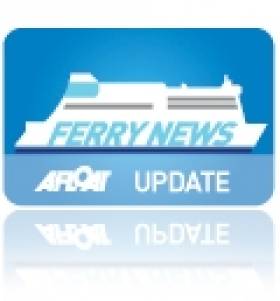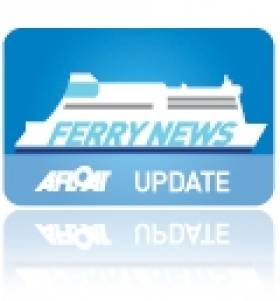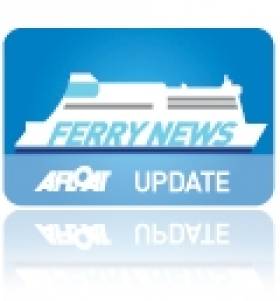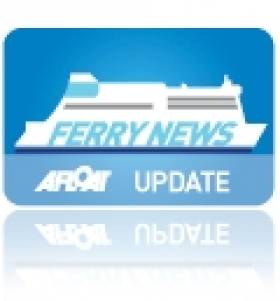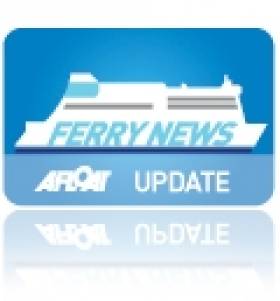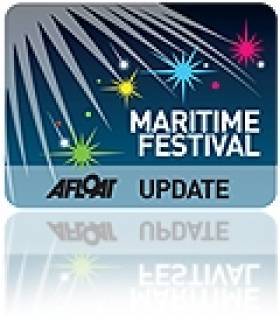Displaying items by tag: Celtic Link Ferries
Ferry Firm and Port Reach Deal Over Fees
#FERRY NEWS – Celtic Link Ferries which operates on the Rosslare-Cherbourg route has reached an agreement with Rosslare Europort, to end a stalemate in over €100,000 relating to port landing fees. It comes after the port company recently lodged a petition in court to wind up the company over alleged unpaid bills.
The O'Flaherty brothers who own Celtic Link along with partner O'Leary International Transport Company said that the ferry firm were being overcharged in comparison with competitors Stena Line and Irish Ferries and other ports around the country.
Rosslare Europort had been demanding a landing fee of €14.92 for cars and €48 for freight vehicles, however for some time Celtic Link Ferries have been paying €3 for cars and €35 for freight vehicles, as they believed that this was approximately what their competitors were paying.
For more on this story as reported in last week's edition of the Wexford People click HERE.
#FERRY NEWS – A £4m upgrade of Stena Line's Belfast-Birkenhead (Liverpool) sisters has been completed at Harland & Wolff. The work was carried on the pair of 27,000 tonnes ships by Newry based specialist marine outfitters MJM Marine, writes Jehan Ashmore.
Work on the 980-passenger vessels Stena Mersey and Stena Lagan began in March and ended last month. During that timeframe the Stena Feronia which was in a collision with a cargoship in Belfast Lough, was deployed to cover the overhaul of the sisters, now sporting Stena Line livery.
The investment programme introduced on board entails facilities such as a lounge pod-area featuring several iMacs, a trucker's lounge, free wi-fi and a bar & grill and a restaurant.
In addition the refurbishment has improved customer experience with the inclusion of an improved shop, improved guest services, and cinema offering guests free movies during the north Irish Sea crossing.
The pair built by Visentini, the Italian shipbuilder based near Venice, can handle 2,662 freight lane metres are now owned by a subsidiary of Stena Line, in the form of Stena RoRo which purchased the vessels from a German bank.
Beforehand the ferries were part of Epic Shipping which chartered them in turn to DFDS Seaways. The Danish owned operator's short-lived Irish Sea route network venture was sold last year to Stena which included the sisterships.
Stena RoRo also purchased the Visentini built ro-pax Watling Street and also from the same yard the former Celtic Link ro-pax Norman Voyager, which is currently back on its original Portsmouth-Le Havre route running on charter to French ferry operator LD Lines.
Meanwhile Celtic Link's existing Rosslare-Cherbourg route vessel Celtic Horizon, is on a five year charter from an offshoot of the same Italian shipbuilder and again is another vessel of the successful ro-pax design.
Got that Friday Ferry Feeling….Like It
#FRIDAY FERRY FREEBIES – Celtic Link Ferries have launched a new 'Friday Ferry Freebies' campaign where they are giving away the chance of winning a return trip to France on the Rosslare-Cherbourg route, writes Jehan Ashmore.
The prize is for a round-trip that includes two adults travelling in a car or campervan with cabin in each direction, subject to availability. The offer is valid during May, September, October, November and December 2012.
For a chance to win the Wexford based operator ask you to like and share on their Facebook page by visiting www.facebook.com/celticlink. The first winner is to announced this afternoon.
This is the first high-season that the company's Celtic Horizon will be operating the French route since the ro-pax ferry was launched last October.
French Routes Rivals Vie for Market-Share
#FERRY NEWS- Established ferry operators on routes to France are gearing –up for market share with the first battle for 2012 targeting the Spring Easter period, with recent T.V. advert campaigns launched by Irish Ferries and Brittany Ferries, writes Jehan Ashmore.
Last week Irish Ferries reopened Rosslare-Cherbourg sailings by the cruiseferry Oscar Wilde (1987/31,914grt). The largest ever vessel to serve Irish Ferries French routes will also resume high-season sailings to Roscoff in May. For sailing times of both routes click HERE.
Brittany Ferries will embark their season with Cork-Roscoff sailings on 31st March with 'flagship' Pont-Aven (2004/41,748grt). This route operates a single weekend round-trip schedule, with arrivals and departures to Cork each Saturday, for more on sailings click HERE.
While Celtic Link Ferries, which entered the continental sector in 2005 having taken over from P&O (Irish Sea) introduced a new vessel on the Rosslare-Cherbourg route last October with the chartered ro-pax Celtic Horizon (2006/27,522grt) as previously reported on Afloat.ie.
Unlike their rivals, Celtic Link Ferries are the only operator to maintain year-round sailings in this sector, for schedule click HERE.
Severe Weather Disrupts Ferry Services
#FERRY NEWS – With travel disruption to some Irish Sea ferry services due to the severe weather conditions battering across the country, the following ferry operator's website links below provide the latest sailing schedules and contact details.
It is also advisable to contact the ferry operator to inquire about the port check-in time prior to setting off. For further information click over each of the route as highlighted below.
In addition to keep abreast of weather warning updates click www.met.ie/ and www.metoffice.gov.uk/
IRISH FERRIES
Central Reservations Tel: 0818 300 400 OR
Rosslare Tel: (053) 9133158
Rosslare-Cherbourg: Sailings have been temporarily suspended due to annual dry-docking of the cruiseferry Oscar Wilde. Sailings resume with the first departure in 2012 from Rosslare on 19th February and the corresponding return sailing from Cherbourg is scheduled for 21st February. For timetable click HERE.
STENA LINE
Tel: (01) 204 77 99 when travelling to Britain OR
Tel: 00 44 (0) 8705 755 755 when travelling to Ireland or Scotland.
Dun Laoghaire-Holyhead Note: the high-speed (HSS) route remains suspended until April or May 2012.
Belfast-Liverpool (Birkenhead)
P&O Ferries
Tel: 00 353 (0)1 407 3434
Larne-Troon. Note: the 'Express' fast-ferry craft operated route is due to re-open in March 2012.
KINTYRE EXPRESS
Tel: 00 44 1586 555 895
Note: FOOT-PASSENGER ONLY fast-RIB craft service which is currently operating to a winter service (October 2011-April 2012) which runs only on Friday's and Monday's.
CELTIC LINK FERRIES
Tel: (053) 916 2688
FASTNET LINE
Tel: (021) 437 8892 OR UK 00 44 (0) 844 576 8831
Note: The Celtic Sea route is due to re-open on 6th April 2012 with a sailing from Swansea.
Celtic Horizon Officially Enters Service
She replaces the Norman Voyager which too was built by Visentini. The 186m ro-pax vessel last week arrived from the Mediterranean (to read more click HERE) and will be chartered to CLF for a five-year term contract. Overall she has a larger passenger deck compared to her predecessor, with a restaurant, two bars, pull-man lounges, a cinema, children's play-area, game-zone and kiosk-shop.
In addition to her 130 cabins she has five vehicle decks for 200 cars and a total 2,500 lane freight metres equating to around 110-trucks. An unusual feature is an escalator that whisks passengers from the car-decks up to the passenger deck.
Prior to the event, Celtic Horizon had arrived into the Wexford port. She had completed her maiden 'Irish' round-trip commercial voyage over the weekend from Cherbourg during stormy seas under the command of Captain Richard Collins.
Last year CLF handled 60,000 passengers and 50,000 vehicles between tourist vehicles and freight business. This year they are expecting an increase of passenger traffic of around 30%. The company are the only ferry operator running year-round sailings on the Irish –French routes.
CLF took over the Rosslare-Cherbourg route from P&O in 2005. With the Celtic Horizon they will continue providing three-round trips per week on the route which transports passengers, tourist cars, camper-vans, freight trucks including livestock and the importation of French manufactured new trade-cars.
Wexford Welcomes New Irish-French Ferry Celtic Horizon
The changeover of vessels coincides with the existing Rosslare-Cherbourg sailing schedule of three round-trips per week, noting there are no sailings from the Wexford port on Mondays. Celtic Horizon is due to be introduced with her maiden 'Irish' voyage on Tuesday night, departing Rosslare at 21.30hrs. On the following Monday she is to be officially launched onto the service.
Celtic Horizon will boost capacity on the French route, offering a wider choice of restaurants, bars and a children's play-room. She can carry 840 passengers, 200 cars and 120 freight vehicles. The 186m ferry is from a ro-pax series (including Norman Voyager) designed and built by Cantiere Navala Visentini based in Portoviro, outside Venice.
During her five-day repositioning route from the Mediterranean, Celtic Horizon made an en-route call to Gibralter, anchoring off the British colony on Thursday. Another of the same Visentini ro-pax class vessels, Cartour Epilson is believed to have taken over Celtic Horizon, formerly named Cartour Beta when she served her last season between Termini Imerese in Sicily to Salerno while on charter to C&T.
CLF will be the only ferry operator running services to France, between 2 January -19 February 2012, as Irish Ferries, which also operates on the Rosslare-Cherbourg route, will be taking off Oscar Wilde for annual dry-docking. For schedules click HERE.
In addition there will be no sailings between Cork-Roscoff, as Brittany Ferries final sailing for this year is 29 October, served by 'flagship' Pont-Aven. The 2012 season starts in late March.
New Celtic Link Ferry on Re-Positioning Voyage off Africa
CLF are to charter Celtic Horizon for a five-years and the 25-knot capable vessel will takeover the existing thrice-weekly round trip sailing schedule from ro-pax Norman Voyager. Between 2 January -19 February 2012, CLF will be the only continental ferry operator running services as rivals Irish Ferries will be taking their cruiseferry Oscar Wilde for annual dry-docking. To read more click HERE.
In addition there will be no sailings between Cork-Roscoff, as operators Brittany Ferries last sailing for this year is 29 October, served by 'flagship' Pont-Aven. The 2012 season starts in late March.
Celtic Horizon is the first vessel to be named with a 'Celtic' prefix of part of their ferry operations, since the company brought European Diplomat from former route operators P&O (Irish Sea) in 2005. The freight-ferry renamed Diplomat, served Celtic Link Ferries until 2009. Since then she has been on charter in the Caribbean until this summer when she was sold to the breakers in Alang, India. To read more click HERE.
As for Celtic Horizon, she was built in 2006 and spent her last season this year as Cartour Beta while on charter to C&T's routes between Naples and Sicily, to read more click HERE. The 186m ro-pax is believed to be heading for Gibraltar while en-route to Rosslare.
During her Irish service, she will maintain Italian registry of Bari whereas her predecessor Norman Voyager changes flags from the UK to that of the French tricolour. Both vessels are similar as they share a ro-pax design which has proved popular for Italian shipbuilders Cantieri Navali Visentini.
The 2008 built Norman Voyager of 26,904grt is to revert to LD Lines operation and used on their 'Motorways of the Seas' St. Nazaire-Gijon service, though she was to enter on the Marseilles-Tunis route. Her new role on the Franco-Iberian route sees the replacement of Norman Asturias.
New Vessel on the Horizon for Celtic Link Ferries
With an increased capacity of nearly 1,000 passengers accommodated in 428 cabin berths, the vessel will offer a wider choice of bars, restaurents and childrens' play area compared to the current route ro-pax Norman Voyager, which like her successor was built by Italian shipbuilders Visentini. The 25-knot replacement ship will have 2,285 lane metre space for 800 cars or 150 freight vehicles.
Celtic Horizon becomes the first vessel to incorporate the companies name since foundation in 2005 when the freight-ferry Diplomat started operations. In recent years the company has secured the contract to import new trade vehicles from French manufacturers.
Before the newcomer makes her Autumnal debut, the 2006 built vessel is currently operating as Cartour Beta while on charter to Caronte and Tourist's (C&T) Salerno-Messina service in Sicily. To read more click here.
As for the Norman Voyager, she first entered as a newbuild in 2008 for LD Lines weekend operated Rosslare-Le Havre route, subsequently transferred to Cherbourg. LD Lines first foray into the Irish market was short-lived as the ro-pax was sub-chartered to Celtic Link Ferries the following year, though the French company are to transfer the vessel to their Marseilles-Tunis route in November.
- Diplomat
- Celtic Link Ferries
- Ports and Shipping
- RosslareCherbourg
- Norman Voyager
- Visentini
- RoPax
- FreightFerry
- Ferry news
- LD Lines
- Cartour Beta
- Caronte and Tourist
- Visentini ropax
- RosslareLe Havre
- SalernoMessina
- MarseillesTunis
- Irish ferry market
- IrishFrench ferry services
- Irish ferry sector
- Irish Ferries
- RoPax Norman Voyager
- Rosslare Port
- Rosslare Europort
- French trade vehicles
- Citreon
- Peugoet
- Renault
Sun, Sand and Sail at the Kilmore Quay Seafood Festival
The Kilmore Quay Seafood Festival starts this evening, now in its 42nd year, the four-day festival is surrounded by the culinary delights of locally caught fresh seafood, writes Jehan Ashmore.
In addition festival-goers can take part in the varied programme which caters for all age-groups. At 7.30pm tonight is the opening Grand Festival Parade featuring a 'Visitors From the Deep' float and Wexford's Community Samba Band 'Bloco de Fud Este'.
The festival will include a Seafood Platter Prize Competition, a children's creative art-workshop making 'Fish Kite-Windsocks', a Friday Fish Market with reduced prices and chefs cooking culinary dishes for sample-tastings and a Beach Band Barbecue.
On both the Saturday and Sunday there is the Tuskar Marine Modellors with their model boats and ships exhibition held in the Stella Maris Centre
and the Quay Times exhibition. Also throughout the weekend the Festival Arts Exhibition will be open in the RNLI Lifeboat House, noting Kilmore Quay is the first Irish lifeboat station to have the new Tamar-class lifeboat, the RNLB Killarney which can be viewed at its moorings.
On Saturday starting at 2.30pm is the "The Celtic Link Challenge" - Yacht Race when boats leave the marina at 3pm and return two hours later. The winners trophy will be presented in the Bird Rock Cafe at 6pm. If adverse weather conditions prevail the race will be re-scheduled for 2.30pm on the Sunday - weather permitting! For more information contact 086 2576862 and www.kilmorequayboatclub.com
To view the complete list of the festival programme, noting certain events and activities require an admission charge click HERE
- RNLI
- Tamarclass lifeboat
- Maritime Festivals
- Kilmore Quay Seafood Festival
- Kilmore Quay Marina
- Irish Seafood Festivals
- Stella Maris Centre
- RNLI Lifeboats
- RNLI Killarney
- Tuskar Marine Modellors
- Boat Models
- Seafood Platter
- Celtic Link ChallengeYacht Race
- Kilmore Quay Boat Club
- Fish Markets
- Beach Band Barbecue
- Celtic Link Ferries


























